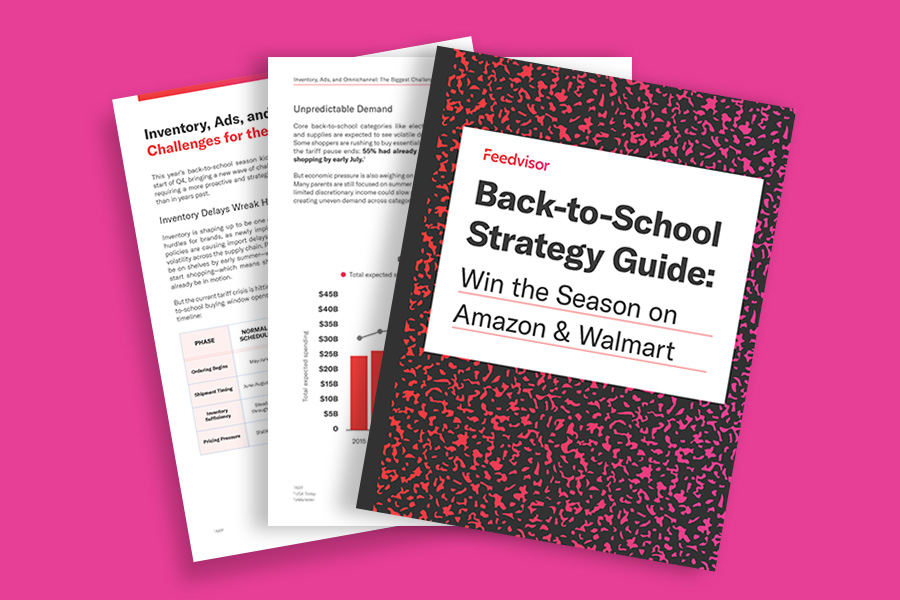Categories
Latest Posts
Tags
Advertising Amazon Amazon Advertising Amazon Experts Amazon Listing Optimization Amazon Marketplace Amazon News Amazon Prime Amazon Professional Sellers Summit Amazon Seller amazon sellers Amazon Seller Tips Amazon Seller Tools ASIN Brand Management Brands Buy Box Campaign Manager Conference COVID-19 downloadable Dynamic Pricing Ecommerce FBA FBM Holiday Season industry news Multi-Channel Fulfillment Optimize pay-per-click Pricing Algorithm Pricing Software Private Label Profits Repricing Repricing Software Revenue Sales Seller Seller-Fulfilled Prime Seller Performance Metrics SEO SKU Sponsored Products Ads Strategy
Get the latest insights right in your inbox

How Does Amazon’s A9 Search Engine Work?
Amazon’s A9 Search Engine Deconstructed: What You Need to Know
As Amazon solidifies its position as the dominant search engine for product discovery and purchase, you need to take proactive measures to ensure healthy product rankings and SEO-rich detail pages to drive consumer conversion.
Given Amazon’s highly saturated and deeply competitive marketplace, it can seem difficult or even impossible to improve your product rankings and visibility. To mitigate this challenge and help you navigate Amazon’s search algorithm, we created this guide that is entirely dedicated to implementing and executing an effective Amazon SEO strategy.
Without thorough knowledge of Amazon’s A9 search engine and its nuances, you are not only sacrificing traffic and sales, but you are giving in to and blending in with the competition. Inclusive of insights that will help you understand Amazon’s A9 algorithm and best practices to enable higher rankings on Amazon, this actionable guide is the key to unlocking improved engagement levels, more relevant traffic, and even net new customers.
What Is Amazon SEO?
SEO stands for search engine optimization, the process of increasing the quality and quantity of traffic from the organic or natural search results on search engines. However, because of user intent, Amazon’s search engine operates quite differently than a search engine like Google.
Given that Amazon is a product-based search engine designed for making purchases, it has an advantage because it does not need to consider informational search intent such as “how to” searches from users. Instead, it can focus on pairing consumers with the most relevant products based on their search.

Optimize Your Keywords With Our AI-Driven Advertising Solution
How Amazon’s A9 Search Algorithm Works
Amazon’s algorithm is known as A9, named after the company’s subsidiary that handles SEO. If you have performed a search on Amazon, you have used the A9 search engine. Amazon used to have an A9 website on which it stated that the A9 team analyzes data, observes historical traffic patterns, and indexes the text describing every product across Amazon before the customer even decides to input a search query — all to optimize the customer experience and better help shoppers find the products they want.
To perform a search at scale, Amazon’s search engine and algorithms determine which items are the most optimal matches with the customer’s query and then scores them based on the item’s level of relevancy to the consumer.
Amazon’s ranking algorithms automatically learn to combine multiple relevance features and analyze past search patterns to adapt to what is most important for customers. As mentioned earlier, Amazon searches are transactional and not informational. The A9 search algorithm, as a result, is built on two core tenets: performance and relevance. A product with strong sales performance history will rank higher in Amazon’s search results, as will a product that uses the proper keywords to effectively match a customer’s search queries.
For performance, ask yourself how much money you are making on Amazon. The more sales you generate, the more Amazon benefits. Products that earn sales on Amazon will be prioritized. For relevance, ask yourself how relevant your product is to what the consumer is searching for. When optimizing your product listings on Amazon, keep these two factors front of mind to increase your chances of higher organic rankings.
Amazon Ranking Factors
When establishing an Amazon SEO strategy, be sure to optimize for customer conversion first. Amazon rewards listings that perform, not necessarily listings that are stuffed with keywords. While it may be tempting to densely pack all of your keywords into your product title, description, bullets, and backend search terms, you need to remember that you want the listing to resonate with and spark engagement from the customer.
In this section of the article, we will explain actionable steps you can take to optimize your keywords rankings and on-page content and improve your overall product visibility on Amazon. As a result, improved visibility will lead to an increased velocity of sale and level of conversion.
Related to Relevance
1. Product Title and Brand Name
The utmost relevant keywords for your product should go in your title. According to Amazon, titles should be approximately 60 characters long and should mimic what would be on the physical packaging of a product. Although it should be included in your Amazon product title, your brand name also appears after the product title and links to a list of your brand’s additional products or Amazon Store, if you have one. If customers filter by brand and your listing is missing the brand designation, the customers may never locate your listing.
The product title should clearly identify what is being sold and should strike a balance between being both brief and keyword-rich. You should specify the color and size of each unique product in the title, as well as the quantity included, if applicable. The words included in the title will determine where the product shows up in search results, so make sure that your title is both concise and relevant to your target audience. Amazon has put together thorough Category Style Guides for you to follow, given that each product category requires a unique title structure. One example is below:
Apparel Title Format:
[Brand] + [Department] + [Product Name] + [Size & Color] (for products with variations)
Apparel Example:
Adidas Women’s Supernova Tee Medium Pink
2. Backend Keywords
Amazon gives you the chance to add “hidden” keywords to your product listings. Although not displayed, these keywords are extremely useful for optimizing your search results. Amazon limits the length of these search term attributes to less than 250 bytes, a limit that applies to both newly registered and existing ASINs. This section is where you can include any keywords that did not naturally fit into the title or description, other high-ranking long-tail keywords, variations, and even abbreviations that rank highly.
You may want to create a list of your top keywords, add them in other fields, and then see what you have left for the backend. Below are a few tips to optimize your search terms:
- Stay under the length limit. If your backend keywords exceed the 250 bytes limit, they will not be indexed by Amazon and your product will no longer be displayed for those keywords in Amazon’s search results.
- Include synonyms.
- Include spelling variations, but there is no need to include misspellings.
- Include abbreviations and alternate names.
- You can use all lowercase characters.
- Separate words with spaces.
- Do not include product identifiers such as ASINs, your brand name, or other brand names in the search terms field.
- Avoid temporary statements such as “new” or “on sale now.”
- Do not use subjective claims such as “best” or “amazing.”
- Do not add abusive or offensive terms.
- Do not repeat any keywords.
3. Product Bullet Points
Here, you can include up to five bullet points to highlight the core features and benefits of the product while incorporating your most important keywords. The bullet points show up in an “About the product” section and provide a quick snapshot overview of the product, so you should save that space for the most important information that you want to convey, such as why your products may be better than a competitor’s option. Think about customer pain points and address how your product solves them in this space.
4. Product Description
Amazon’s A9 algorithm tends to prioritize products that sell more, so you want to write a compelling description that leads to conversions rather than simply being informational. The product description is where you can provide more detailed product information and more engaging marketing language to help answer any potential questions that the customer might have, while simultaneously demonstrating any value-added benefits or features of the product.
Be sure to cover the information that customers would use when comparing similar products. Try to make your copy sound natural and convincing from a sales point of view, while also including your relevant keywords in a natural way.
Thorough product descriptions allow the customer to imagine the experience of handling or owning the product themselves. What would you want to feel, touch, ask, or see if you were in their position? The description is an ideal location to represent your brand story and mission, gain trust and establish credibility, call out target customers, and mention a scenario where your product would typically be used. Keep in mind that the descriptions should be limited to 2,000 characters to avoid losing the customer’s attention.
Overall, it is clear that having a detailed, optimized product listing page will allow customers to absorb any possible information that they would need to make a buying decision. Your descriptions should be informative, succinct, and help your product rank well, so do not forget about including keywords throughout that will align with the search terms your target audience will input. By creating user-friendly, easy-to-understand product listings, consumers will be more inclined to purchase your products after landing on your product detail pages.

Increase RoAS and Decrease ACoS with Feedvisor
Try our AI-powered advertising optimization solution today.
Related to Performance
Ranking factors related to performance are harder to control because there are factors outside of keywords that are at play. However, you should have a strong understanding of these factors in order to have a comprehensive Amazon SEO optimization strategy.
1. Sales Performance History
The more sales you produce on Amazon, the higher you will rank. A high sales velocity is immensely beneficial to Amazon, so the A9 algorithm will analyze sales results and increase the rankings for the products that sell well. With a higher conversion rate and increased sales velocity, you will accelerate additional sales and generate positive customer reviews, fueling the flywheel effect.
If you are working with new products and need to build up sales, you can experiment with Amazon pay-per-click (PPC) campaigns, run a giveaway promotion or offer a percentage off, and ensure that you are priced competitively. By leveraging real-time price optimization, such as with Feedvisor’s best-in-class pricing technology, machine-learning algorithms identify the optimal price for your products despite constantly changing market dynamics.
2. Price
The prices that you set for your Amazon products can greatly impact your conversion rate and sales performance. If you price your products strategically and competitively, your conversion rate will benefit. Be sure to do a competitive analysis to understand at what price points your competitors, both on and off of Amazon, are listing similar products.
Feedvisor’s holistic price optimization and intelligence platform continually analyzes your constantly changing competitive landscape and understands the optimal pricing to ensure the right balance of sales velocity and profitability. By maintaining that balance on an ongoing basis, your conversion rate should be positively impacted, which can, in turn, improve your organic ranking.
3. Product Availability
A product’s in-stock history can certainly aid in determining product ranking for any given product search. If, for example, you need to increase prices to conserve the remaining inventory that you have on a particular ASIN, your sales performance will take a negative hit as a result. With higher prices, your sales volume and conversion rate will decrease, which can, in turn, damage your ranking position.
Additionally, you can only increase your prices for so long until either the product completely goes out of stock or sales come to a complete halt. Once the product is back in stock, your keyword rankings need to build themselves back up to where they were before the price increases and stockout. Products can regain their previous rankings after they are restocked, as long as sales can be generated in a timely manner.
While low stock levels can directly lead to a decrease in sales and a lower conversion rate, having surplus inventory can result in many hidden expenses. These expenses include long-term storage fees, obsolescence, loan interest, and alternative costs of not investing in new products. Inventory levels impact not only your sales but also your expenses.
If you do not do so yet, prioritizing routine inventory replenishment should be a part of your regular work routine. Running out of stock means 0% Buy Box and no conversion. Replenishing your top-selling items is a low-hanging fruit process that can be taken care of on a weekly basis by reviewing your top 20% of selling items to estimate how much inventory you need to order before going out of stock.
By leveraging Feedvisor’s best practices and AI-powered inventory management insights, you can understand which actions to take to maximize inventory ROI and maintain a healthy inventory position — both of which help maintain sales, conversion rates, and organic rankings.
4. Product Images
Although images are not a direct, performance-related Amazon ranking factor, they play a critical role in both your click-through and conversion rates. Generally, the higher these metrics are for a certain keyword, the higher your product will rank in search results for that keyword.
Your product images are shown when the customer clicks through to the detail page. You can showcase seven to nine images related to the product at hand and they should meet Amazon’s Image Requirements. If possible, allow the zoom function to work on the images and show the product from multiple angles as well as in use to help the customer understand what it would actually be like to buy and use the product.
5. Customer Reviews
Reviews are another indirect factor that can impact your product’s rank on Amazon. Customer reviews can significantly influence your conversion rate, which demonstrates their important role in Amazon SEO. Products with strong ratings (four stars or higher) are more likely to rank higher in Amazon search results than those with less than four stars.
To check product reviews, more than three-fourths (79%) of consumers go to Amazon prior to making a purchase, so you should constantly monitor your reviews to ensure customers do not abandon their potential purchase due to a negative review. By responding to negative reviews in a timely fashion, you are showing your prospective customers that you value their time and experience with your products, as well as maintaining a positive overall customer experience.
Final Thoughts
Amazon now owns a 56.7% share of the entire U.S. retail market, including both online and offline channels. More than two-thirds of all product clicks on the vast marketplace take place on the first page of search results, underscoring the critical importance of establishing an “always on” approach to SEO.
If you are ranking-conscious on Amazon, focus on improving your sales velocity and remaining on pace with demand, which will, in turn, benefit your conversion rate, keyword targeting capabilities, and customer loyalty and engagement levels.




